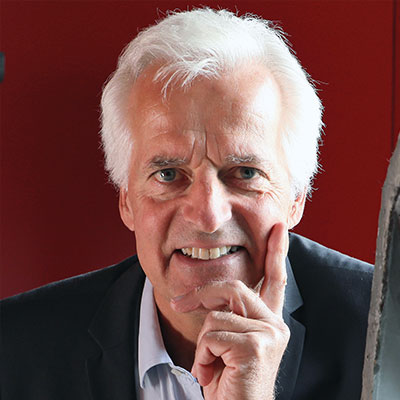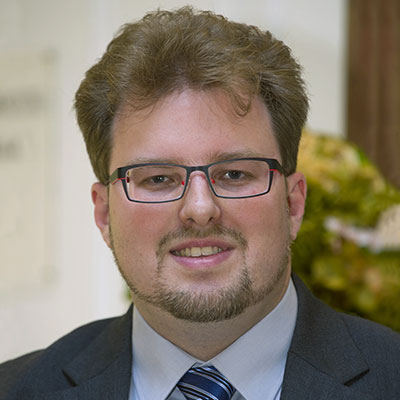Fazlur R. Khan Plenary Lecture
Making Bridges Sustainable

Eugen Brühwiler
Swiss Federal Institute of Technology Lausanne (EPFL)
Lausanne, Switzerland
Lack of incentives mainly explains why the implementation of novel methods and technologies in bridge engineering practice is generally postponed by the structural engineering community despite the urgent need to advance bridge engineering to meet the objectives of sustainability. This lecture will show how novel engineering methods and technologies extend the service duration of existing bridges while meeting the requirements of modern use. Accurate determination of in-situ bridge behaviour using data from long term monitoring of traffic action effects allow to verify realistically the structural and fatigue safety of bridges. If interventions are necessary, a targeted use of advanced high-performance materials such as UHPFRC (Ultra-High Performance Fibre Reinforced Cementitious Composites) allows to rehabilitate and strengthen effectively reinforced concrete bridges. This approach follows the principles of sustainability. Recent research results and application cases will be presented focusing on the benefits regarding sustainability, including cost considerations as well as environmental and social impacts.
Keynote Lectures
Resilient Structures: Materials | Components | Systems

Mark Sarkisian
SOM – Skidmore, Owings & Merrill
San Francisco, CA, USA
Materials, components, and systems are all essential to creating resilient structural systems. Historical, materials have been used based on technologies of the time including an understanding of mathematics, physics, and engineering. Modest-strength materials, when assembled creatively can provide significant resistance to gravity and lateral loads. When intelligently placed, these materials can form structures that are even self-stabilizing during construction without the need for forming systems. Structural components designed for maximum life and performance can transform brittle structures into those with ductility where damage can be reduced when subjected to extreme loadings such as those created from seismicity. Structural systems can be comprised of multiple types of materials and can be assembled into efficient structures at all scales. New advancements in design include super-elastic materials that can be used to dissipate energy during seismic events and even provide self-centering of structures after strong ground motions. Several building examples with be described and presented. These examples will be based on fundamental concepts of life-cycle engineering including ideas that help reduce embodied carbon through initial construction and long-term behavior. Ideas include structures that incorporate seismic isolation, friction fuse devices, and even new concepts using Shape Memory Alloys (SMA).
Probabilistic Life-Cycle Performance Assessment of Corroded Concrete Structures: Core Technologies to Predict the Remaining Service Life

Mitsuyoshi Akiyama
Waseda University
Tokyo, Japan
Keynote Paper co-authored by:
Dan M. Frangopol, Lehigh University, PA, USA
For concrete structures located in an aggressive environment, multiple environmental and mechanical stressors lead to deterioration of their structural performance. Such deterioration will reduce the service life of structures and increase the life-cycle cost of maintenance actions. Various environmental stressors such as airborne chloride affect the degradation mechanisms of concrete structures. However, the effects of these stressors are difficult to predict, as they vary in time and space. Because of the presence of such uncertainties, long-term structural performance must be predicted based on probabilistic concepts and methods, and life-cycle reliability assessment methodologies must be established. This keynote presentation will introduce core technologies for probabilistic prediction of the remaining lifetime of deteriorating concrete structures. They include:
(a) X-ray technology and digital image processing: Modelling the steel corrosion is important, but steel corrosion in RC members can only be observed after severely damaging these members. To understand the steel corrosion growth process, continuous monitoring is necessary. Novel X-ray and digital image processing techniques have been applied to observe steel corrosion in RC members. The experimental outcomes will be introduced to provide a fundamental understanding of the non-uniform spatial growth of the steel weight loss and the corrosion cracking.
(b) Reliability assessment with the stochastic simulation: The deterioration of RC structures due to chloride-induced corrosion is not uniform because of the spatial variability related to material properties and environmental stressors. This variation has a substantial effect on the reliability of RC structures. Based on the experimentally obtained model parameters, the spatial steel weight loss distributions in the longitudinal and transverse directions are simulated by 2D spectral representation method. Life-cycle reliability of concrete structures in a marine environment is estimated taking the spatial variation of material deterioration into consideration.
(c) Finite element models considering the effect of steel corrosion: 3D FE modeling is capable of simulating the behavior of RC members in a more comprehensive way provided that appropriate constitutive models are adopted. Detailed structural analysis with a 3D FE model allows for a more accurate description of the corrosion damage at the material and structural levels. Comparison between experimental and computational results demonstrates that the 3D FE model provides better predictions of the structural behavior of the corroded RC members with multiple rebars than the 2D FE model, especially when the member has a small correlation coefficient of steel cross-sectional area loss in the transverse direction. The 3D FE model is recommended for evaluating the structural performance of corroded RC members.
(d) Machine learning: Machine learning-based approaches have gained attention owing to the capability of simulating the complex physical process for structural assessment. With the aid of the three core technologies mentioned previously (i.e. (a), (b) and (c)), an artificial database for developing the machine learning model is generated to predict the steel corrosion distributions inside the concrete members using the corrosion crack widths.
In an illustrative example, the remaining lifetime of a deteriorating concrete structure is probabilistically estimated using the inspection results (e.g. observational information on corrosion crack widths taken by using a drone). Finally, future issues necessary to advance the life-cycle analysis of deteriorated concrete structures are discussed.
Field and Laboratory Tests for Corrosion Assessment of Existing Concrete Bridges

Maddalena Carsana
Politecnico di Milano
Milan, Italy
Keynote Paper co-authored by:
Elena Redaelli, Politecnico di Milano, Milan, Italy
Fabio Biondini, Politecnico di Milano, Milan, Italy
Many existing reinforced concrete structures built around the middle of the last century have now reached the end of service life and require maintenance interventions to repair degradation damage, especially due to corrosion of steel reinforcement. Therefore, a relevant and urgent problem is the conservation of existing structures and infrastructural facilities such as bridges and viaducts that, due to their social and economic importance, are included among the most critical assets of cultural heritage. In order to correctly define the restoration interventions and fulfill safety, robustness and durability requirements, it is necessary to monitor reinforced concrete structures and assess the state of degradation of materials and corrosion of embedded steel. The aim of the lecture is defining the criteria, methods and procedures actually available for corrosion assessment of existing concrete bridges and viaducts. At this purpose, the results of inspections carried out on bridge structural members subjected to corrosion and exposed to different environmental conditions and microclimates will be presented by focusing on in field non-destructive testing as well as sampling of materials in order to perform both chemical and microstructural analyses on concrete, complemented by electrochemical tests on steel reinforcement.
Bayesian Assessment of Existing Concrete Structures: Exploiting the Full Power of Combined Information

Robby Caspeele
Ghent University
Ghent, Belgium
Keynote Paper co-authored by:
Wouter Botte, Ghent University, Ghent, Belgium
An increasing amount of the current activities in the construction sector are oriented towards the assessment of existing structures and the associated repair and upgrading interventions. Although the last decennia significant progress has been made to analytically and numerically simulate the degradation process of concrete structures and their associated structural performance prediction in time, structural engineers are challenged to deal with the large uncertainties involved. Besides a typical lack of information, the degradation processes are associated with large uncertainties and when executing additional investigations and measurements, significant model and measurement uncertainties play a dominant role in the reliability-based performance prediction. Bayesian updating techniques provide a unique engineering tool to adequately combine and fully exploit the power of combined available information, enabling to make inferences where classical statistical approaches fail. After revisiting some basics on Bayesian approaches, it is explained and illustrated how Bayesian updating techniques provide an undeniable advantage in several steps of the assessment process. Degradation models whose parameters generally are difficult to find consensus about, can gradually be updated when more information becomes available. Variables in structural reliability calculations can be updated on the basis of direct as well as indirect measurement data. Sources of information contained in different types of measurements or even visual inspections can be combined in order to make much more informed inferences and to reduce uncertainties in the reliability-based performance assessment, compared to when such data is analysed separately. Semi-probabilistic assessment approaches can be adjusted on the basis of updated uncertainties. And finally, the positive effect of quality control can be taken into account when assessing the structural reliability. The integration of these approaches into the practical assessment process is proven to be feasible and an outlook is given on future engineering challenges to integrate such approaches further in the life-cycle assessment of existing concrete structures.
Safety Assessment of Civil Infrastructure Assets Subjected to Extreme Events

Michel Ghosn
The City College of New York / CUNY
New York, NY, USA
Civil infrastructure systems are exposed to various types of human-made, environmental, and climatic hazards within their service lives. Reliability-based approaches and probabilistic risk–informed methods have long been used for assessing the safety of such systems and developing design standards and specifications to account for the random nature of these hazards, their intensities and rates of occurrence, and possible compounding effects. Specifically, current design standards provide reliability-calibrated design load maps and tables as well as load combination factors for use in engineering practice during a structure’s safety check process. These maps and associated procedures are based on historical data assuming that the underlying processes are unchanging over time where observed variations in the historical data are only random oscillations around stationary means and underlying statistical properties. However, ageing processes, growth in economic activities, and climate change are causing increases in the frequencies and intensities of related hazards, raising the risk to infrastructure systems and their users. This presentation will review the fundamental principles behind structural code developments and their underlying assumptions. It will also examine analytical methods to assess the safety of structural systems accounting for the nonstationary nature of hazards. The presentation will discuss approaches for adjusting current structural design specifications in view of anticipated climate change scenarios. Numerical examples will illustrate the application of these approaches during the safety assessment and the design of bridges and other structural systems.
The Digital Transition in Asset Management of Bridges – Advantages and Challenges

Jens Sandager Jensen
COWI A/S
Kongens Lyngby, Denmark
Operation and Maintenance (O&M) of bridges are undergoing a digital transformation, and with better technical- and more cost beneficial equipment (drones, sensors, software etc.), the digital transition accommodates environmental, economic, and technical benefits. Today, most inspections of civil structures are done on site challenged by traffic restrictions, difficult access- and working conditions, and high initial costs (lift, rope access etc.). With high quality thermo- and RGB photogrammetry captured by drones etc., a Reality Model or Digital Twin of the structure may be created, and a Virtual Inspection can be carried out revisiting the structure when needed. The thermo-photogrammetry is used in combination with the RGB-photo to detect hidden defects in the structure such as delamination. In asset management the key interest is to find the optimal point in time to repair or replace structural elements considering the Key Performance Indicators (KPIs) that are important to the asset manager or operator. Combining the Reality Model with Artificial Intelligence (AI) for damage detection and monitoring data from implemented sensors on a web-based platform might be the solution to find the optimal point in time for repair, increase the level of safety (for bridge users and O&M personnel), and minimise traffic disturbance. Working with a Reality Model may also decrease the level of subjectivity and increase the level of transparency in decision-making as well as provide an efficient mean of communication. Despite the many advantages, some challenges remain. They are related to e.g., the reality capture process, AI training, data combination, -presentation and -integration (also with data enriched 3D BIM models for recent bridges) in current asset management systems.
Risk and Decision-Making for Extreme Events: What Terrorism and Climate Change Have in Common

Mark Stewart
University of Technology Sydney
Sydney, NSW, Australia
Terrorism and climate change debates are often characterized by worst-case thinking, cost neglect, probability neglect, and avoidance of the notion of acceptable risk. This is not unexpected when dealing with extreme events. However, it can result in a frightened public, costly policy outcomes, and wasteful expenditures. The presentation will describe how risk-based life-cycle cost approaches are well suited to infrastructure decision-making in these uncertain environments. Structural reliability, systems modelling, life-cycle assessment, and probabilistic methods are used to model infrastructure performance and resilience, risk reduction and effectiveness of climate adaptation or protective strategies, exposure, losses, and costs. The concepts will be illustrated with current research of risk-based assessment of climate adaptation engineering strategies including designing new houses in Australia subject to cyclones and extreme wind events. It will be shown that small improvements to house designs at a one-off cost of several thousand dollars per house can reduce damage risks by 80-90% and achieve billions of dollars of net benefit for community resilience – this helps offset the predicted adverse effects of climate change for a very modest cost.
Life-Cycle Sea-Crossing Bridge Operation under Strong Winds in Severe Weather

Ho-Kyung Kim
Seoul National University
Seoul, Korea
Keynote Paper co-authored by:
Hyeong-Yun Cheon, Seoul National University, Seoul, Korea
Sejin Kim, University of Michigan, Ann Arbor, MI, USA
The strong side winds threaten the stability of running vehicles over the sea-crossing bridges due to the high altitude of the deck and free exposure to the upcoming winds. Therefore, bridge operators control the speed limit or close the bridges when the wind speed reaches predetermined criteria. Since sea-crossing bridges play an essential role in transportation networks, the traffic control strategy, including complete closure, requires a careful assessment of the critical wind speed at which vehicle instability can occur. As the aerodynamic forces on vehicles depend on several influential factors, including the geometrical shape of the superstructure, the critical wind speeds variate bridge by bridge. In addition, road surface conditions such as rainfall or icing can affect the stability of running vehicles. This study demonstrates a framework to determine the critical wind speed considering rain or icing road conditions in severe weather. This study reports two overturning accidents experienced on a double-deck suspension bridge and a cable-stayed bridge. The authors also extended the procedure to the probabilistic risk assessment for the whole bridge life by adding long-term wind data and weather analysis. In this way, this study provides a guideline for bridge operators on balancing driving safety and the continuous mobility of the sea-crossing bridges under hazardous weather and high wind conditions.
The Structural Life of a Cathedral and the Worksites of the Duomo di Milano

Francesco Canali
Veneranda Fabbrica del Duomo di Milano
Milan, Italy
Keynote Paper co-authored by:
Dario Coronelli, Politecnico di Milano, Milan, Italy
The life of Milan Cathedral is described with the evolution of the structural system and the restorations carried out throughout the centuries. The organization of the Veneranda Fabbrica del Duomo di Milano is outlined, with the latest restoration interventions. The case study of the construction and restorations of the Tiburio with its supporting pillars is analyzed, from the initial design to the dramatic damage in the 20th century. The rebirth of the Cathedral was the fruit of restorations preserving the structural identity of the monument up to the present. The conclusions address the study of damage and maintenance and repair operations of monumental heritage buildings within a life cycle perspective, in relation to the underlying societal values.
